Loading AI tools
Le levier de vitesses est une tige (généralement métallique) reliée à la boîte de vitesse d'une automobile qui permet de changer les rapports de vitesse en fonction de l'allure du véhicule. Dans une voiture à boîte automatique, ce levier porte le nom de sélecteur. Le changement de rapport s'effectue en pressant en premier avec le pied gauche la pédale d'embrayage pour désaccoupler les roues du moteur. Les véhicules munis de boîtes automatiques, semi-automatiques ou à transmission à variation continue ne comportent pas de pédale d'embrayage.


Le levier de vitesses est implanté à l'avant du véhicule, à portée de main du conducteur, généralement au centre. Le plus souvent fixé sur la console centrale du véhicule entre les deux sièges avants, le levier de vitesses peut aussi être fixé au plancher ou placé au-dessus du tunnel de transmission, sur le tableau de bord ou intégré à la colonne de direction.
En Amérique, du fait de la présence presque généralisée d'une banquette à l'avant des véhicules (au lieu des classiques deux sièges séparés), le montage du levier de vitesses sur la colonne de direction des véhicules américains était jusqu'à récemment une pratique généralisée.
Gear sticks are most commonly found between the front seats of the vehicle, either on the center console (sometimes even quite far up on the dashboard), the transmission tunnel, or directly on the floor. Some vehicles have a column shift where the lever is mounted on the steering column—this arrangement was almost standard practice in American vehicles from about 1939 until relatively recently. It had the added benefit of allowing for a full width bench-type front seat (though some models with bucket seating as an option include it). It has since fallen out of favor, although it can still be found widely on North American-market pick-up trucks, vans, emergency vehicles (both law enforcement and EMS - the column shifter is retained where a floor shifter is unfeasible due to mounting the mobile data terminal and 2-way radio), and "full-size" US sedans such as the Ford Crown Victoria. A dashboard mounted shift was common on certain French models such as the Citroën 2CV and Renault 4. Both the Bentley Mark VI and the Riley Pathfinder had their gear lever to the right of the right-hand drive driver's seat, alongside the driver's door, where it was not unknown for British cars to also have their handbrake. (Left-hand drive models received a column shift.)
In some modern sports cars, the gear lever has been replaced entirely by "paddles", which are a pair of levers, usually operating electrical switches (rather than a mechanical connection to the gearbox), mounted on either side of the steering column, where one increments the gears up, and the other down. Formula 1 cars used to hide the gear stick behind the steering wheel within the nose bodywork before the modern practice of mounting the "paddles" on the (removable) steering wheel itself.
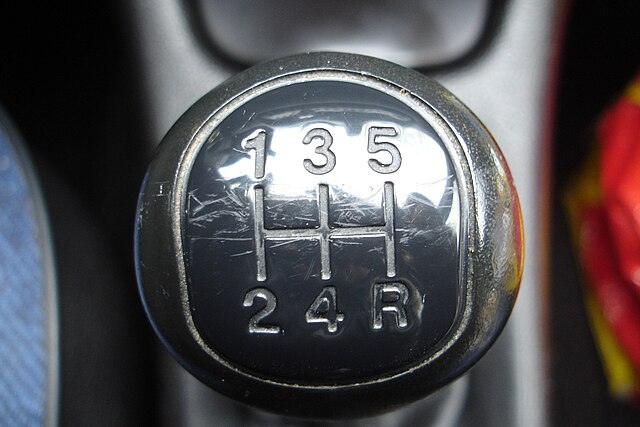
A knob, variously called gear knob, shift knob, gear shift knob, or stick shift knob forms the handle for the gear stick. Typically the gear knob includes a diagram of the shift pattern of the gear selection system; i.e. the positions to which the gear stick should be moved when selecting a gear. In some older manual transmission vehicles it may incorporate a switch to engage an overdrive; in some automatic transmission vehicles it may incorporate a switch to engage a special mode such as a sports mode. Both of the above-mentioned switches may also be found on the console or on steering column stalks instead. Manual shifters on the steering column, if having only three forward speeds, are typically called a "three on the tree." The lowest of these gears, if set at a much lower ratio than standard 1st-gear ratio, is often called a "granny gear".
Learner drivers are taught to rock the knob of a manual gearbox from side to side before starting the engine, to confirm that the gearbox is in neutral (starting the car in gear causes it to lurch forwards since the starter motor has sufficient torque to move the whole vehicle; this can be highly dangerous, especially if the parking brake is not firmly applied). Modern cars require the clutch pedal to be depressed before the starter will engage, for the same reason. The latter practice is also useful in extremely cold conditions or with a weak battery, since it avoids the starter motor also having to turn over a gearbox full of cold and highly viscous oil.
Many automatic transmission vehicles have extra controls on the gear stick, or very close by, which modify the choices made by the transmission system depending on engine and road speed; for example, "sports" or "economy" modes which will broadly speaking allow, respectively, for higher and lower revolutions per gear, before changing up.
Some specialist vehicles have controls for other functions on the gear stick. The Land Rover Freelander introduced a button for that company's Hill Descent Control system feature, which uses the brakes to simulate the function of a low-ratio gearbox in steep descents.
In some traditional four-wheel drive "off-road" vehicles there can be a second gear lever which engages a low-ratio gearbox, used on tough terrain. Further, similar-looking levers may switch between two- and four-wheel drive, or engage differential locks; these are not "gear levers," however.

La grille de passage des rapports fait références aux positions des différents rapports et aux chemins de passage entre eux. Le premier rapport est situé de manière pratiquement standard à gauche puis vers l'avant du point mort. Cependant, on peut rencontrer dans des poids lourds ou des voitures de sport une disposition inverse, le premier rapport étant positionné à gauche et vers l'arrière par rapport au point mort. Usuellement, lorsqu'une vitesse est désengagée, des ressorts fixés sur la tige du levier de vitesses lui permettent de revenir automatiquement au point mort. La position de la marche arrière est choisie de manière à minimiser les risque d'un engagement accidentel.
Transmission manuelle

Une boîte de vitesse manuelle typique de n rapports possède n+2 positions différentes, soit par exemple 7 positions dans une boîte « 5 vitesses » : une position pour chacune et vitesses, une position pour la marche arrière et la dernière position pour le point-mort. Pour empêcher l'engagement accidentel de la marche arrière, certains leviers de vitesses sont équipés d'un bouton spécial permettant de débloquer la position correspondante ; dans d'autres véhicules, les leviers de vitesses doivent être tirés, enfoncés ou déplacés au-delà d'un point dur. Sur les boîtes de vitesses où la marche arrière est située sous le 5e rapport, un verrouillage mécanique permet d'éviter de passer directement de la 5e à la marche arrière, incident qui peut notamment survenir avec des conducteurs qui passent d'un véhicule à 6 vitesses à un véhicule à 5 vitesses.
| Disposition | Description |
|---|---|
 |
Grille la plus couramment rencontrée dans les boîtes à 5 rapports, elle est considérée comme la plus intuitive. Elle alterne les rapports dans le sens gauche-droite et en zigzag de bas en haut puis de haut en bas, depuis la 1re tout à fait à gauche en haut jusqu'à la 5e tout à fait à droite en haut. La marche arrière termine la séquence en étant disposé de manière « logique » tout à fait à droite, vers l'arrière. |
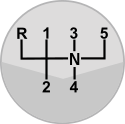 |
Grille de passage de vitesse pour boîte à 5 rapports communément rencontrée sur des véhicules Saab, BMW, Audi, Eagle, Volvo, Volkswagen, Škoda, Opel, Hyundai, Renault, Ford, Holden/Vauxhall, etc. La position de la marche arrière à gauche et à l'avant du point mort permet d'éviter l'engagement accidentel (pouvant causer de graves dégâts mécaniques à la transmission) de celle-ci lorsque le véhicule est en mouvement. |
 |
Cette grille de passage, appelée grille inversée, se rencontre surtout sur d'anciens véhicules munis de boîtes à trois rapports. Plus récemment, elle se rencontrait surtout sur les voitures de compétition (ou les sportives), mais elle est de moins en moins utilisée avec la généralisation des boîtes de vitesses à six rapports. L'intérêt principal de cette disposition est d'accélérer les passages entre 2e et 3e, la 1re n'étant utilisée que pour le démarrage du véhicule. Les boîtes de vitesses de compétition n'étant pas synchronisées, il n'y a aucun retard dans le passage de la 1re à la 2e. Cette disposition peut se rencontrer aussi sur certains poids lourds, où la 1re est un rapport super court utilisé uniquement pour des démarrages en conditions difficiles. |
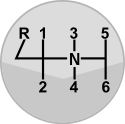 |
Cette grille est celle la plus généralement utilisée dans une boîte à six rapports.
This shift pattern is a typical pattern for a six-speed transmission. Six speeds is the maximum usually seen in single range transmissions, however many semi trucks and other large commercial vehicles have manual transmissions with 8, 16 or even 20 speeds, which is made possible due to multi-range gearboxes. In such a case, Reverse is placed outside of the "H," with a canted shift path, to prevent the shift lever from intruding too far into the driver's space (in left-hand drive cars) when reverse is selected. Higher number of speeds in automobiles are rare occurrences, although examples do exist, such as the Porsche 911, which is equipped with a seven-speed manual transmission. |
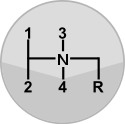 |
Shift pattern for a 4-speed car. |
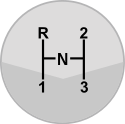 |
Shift pattern for a 3-speed car. |
 |
Shift pattern for a 4-speed column shifter. |
Transmission automatique
Automatic transmissions traditionally have had a straight pattern, adopting the classic P-R-N-D gate, with "P" being to the front, topmost position (or "P" all the way to the left on a column mounted shifter); the corresponding shift positions being:
P = Park - transmission is mechanically locked in position for parking. R = Reverse - reverse motion N = Neutral - no drive applied to the wheels with the engine running D = Drive - forward motion with full automatic operation in all gears.
All automatics use some sort of manual override of the transmission, with numbered positions in descending order marked below (or to the right) of "Drive", which will prevent the transmission shifting to a gear higher than the selected, but maintaining automatic operation between all lesser numbered gears. Such gates will appear as "P-R-N-D-3-2-1" for example. On some vehicles (mainly Japanese makes such as Honda, Toyota and Lexus being good examples) these numbered positions are replaced by a single "L" (for "Low") position, which will hold the transmission in whatever lower ratio is required whenever required for climbing steep grades or for heavy acceleration.
More modern automatic transmissions have employed a "J-gate" (pioneered by Jaguar) where some gears are on the left-hand "arm", some on the right, and there is a sideways movement at the rear of the pattern. The second generation Range Rover from 1995 used an "H-gate", with two parallel PRND gates on the opposing legs of the "H" for both high range and low range ratios, for normal and off-road driving, respectively.
Some modern gearboxes such as the Alfa Romeo Sportronic have a traditional automatic shift pattern to the right, with a special position to the left in which movement of the stick forwards and backwards increments the gears up and down respectively. This can be useful in snow or dirt conditions, where it may be necessary to start from second gear.

With the advent of Drive by wire (or more properly, Shift by wire) computer controlled transmissions (particularly in the case of automatics), the gear stick no longer needs to be mechanically connected to the transmission unit itself, and can therefore be made much smaller since there is no need to package either remote mechanisms or complex interlocking arrangements. This has allowed designers to replace the gear stick completely with either buttons, rotary knobs (current Jaguar and Range Rover models are good examples of this), or a miniaturized gear stick on the centre console - this can be seen in the Toyota Prius and some Audis and BMWs.
Japanese Finger shift is also this.
A shift knob also known as a gear knob, gear shift knob and stick shift knob is the physical interface between the manual transmission stick shift and the drivers hand. Made of many materials from simple plastics through to platinum it comes in many shapes sizes and weights. Generally spherical in shape the OEM versions tend towards the conservative and the automotive aftermarket versions can be found to be of very original design.
The shift knob's principal function is the ergonomical interface between driver and the manual transmission stick shift. The stick shift, as the name implies, is often just a machined or cast aluminium or steel rod with or without threading the shift knob is fitted on its end.[1]
In recent years, manufacturers have increased the variety of shifts knobs available to the consumer from inexpensive plastics to diamond studded white gold.[2]
- 'Big Daddy' Roth 'bloodshot eyeball' shift knob, a 1960s craze.
- Stylized shift knobs can be found on many types of vehicles. This aluminum, hand made, skull shift knob is mounted on a vintage Harley Davidson Knucklehead's "jockey shifter".
A weighted shift knob is a performance driven aftermarket modification which entirely replaces the OEM shift knob and sits atop the aftermarket short shifter or OEM manual shift stick. Initially designed to be used in tandem with a short shifter, it is increasingly being purchased for stock stick shifts. The weight generally varies between 400 and 600 grams or more, depending on the material used. The principle of the weighted shift knob is to make the stick shifter top heavy, thus increasing the throw momentum in order to decrease time between shifts. Weighted gear knobs are offered for sale by a variety of North American based manufacturers in many shapes and finishes, though they are significantly more expensive than the commonly available aftermarket shift knob.
Wikiwand in your browser!
Seamless Wikipedia browsing. On steroids.
Every time you click a link to Wikipedia, Wiktionary or Wikiquote in your browser's search results, it will show the modern Wikiwand interface.
Wikiwand extension is a five stars, simple, with minimum permission required to keep your browsing private, safe and transparent.


